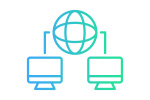Disaster Recovery
Protect your business from the unexpected with our comprehensive Disaster Recovery services. Ensure continuity, minimise downtime, and safeguard critical data through our expert-driven solutions.
Disaster Recovery is a critical component of a business’s overall resilience strategy
Today’s demanding data protection policies require continuous data protection as a key element of cyber resilience. Downtime because of infrastructure failure or human error is not part of the plan. Genisys can bring complete visibility of RPO and RTO in your cloud environment, application-consistent recovery, and near-instant recovery processes across availability zones in the Genisys Cloud, Public Cloud, or even as an extension to your on-premises environment.

Business
Continuity
Minimise downtime and ensure the continuity of essential operations, reducing the impact on revenue, productivity, and customer satisfaction.

Data Protection
and Recovery
Regular backups, replication, and offsite storage mechanisms allow you to restore data to a point before the disruption occurred.

Regulatory
Compliance
Ensuring that critical data is backed up, stored securely, and can be recovered in a compliant manner.

Reduced Downtime
and Losses
Quick recovery from a disaster translates into reduced downtime, enabling your organisation to resume operations swiftly.
What is Disaster Recovery (DR)?
Disaster recovery refers to the set of policies, procedures, and tools implemented by an organisation to restore and resume normal operations after a disruptive event. It involves planning and implementing measures to recover critical systems, applications, and data that may become unavailable or damaged due to natural disasters, cyberattacks, hardware failures, or other unforeseen incidents. The primary goal of disaster recovery is to minimise downtime, ensure business continuity, and restore operations as quickly and efficiently as possible.
Why Choose Genisys for your Disaster Recovery
We possess specialised knowledge and experience in designing, implementing, and managing Disaster Recovery solutions, ensuring best practices and optimal performance. Genisys can provide continuous monitoring, proactive maintenance, and regular testing to ensure the Disaster Recovery plan remains effective and up to date. We have the infrastructure and resources to deliver Disaster Recovery services efficiently, saving businesses from the upfront costs of building and maintaining their own recovery infrastructure.
Key Features of Disaster Recovery

Business Impact Analysis
Before implementing a disaster recovery plan, conducting a thorough business impact analysis is crucial. This assessment identifies critical business functions, systems, and data, as well as the potential impact of their unavailability or loss during a disaster. This analysis helps prioritise recovery efforts and allocate resources effectively.

Risk Assessment and Mitigation
Disaster recovery involves identifying potential risks and vulnerabilities that can disrupt business operations. This includes assessing natural disasters, cyber threats, hardware failures, and other potential risks. Once identified, appropriate measures are taken to mitigate these risks through security measures, redundancy, backup strategies, and other preventive measures.
Backup and Replication
Regular backups and data replication are fundamental components of disaster recovery. Critical systems, applications, and data are backed up regularly and stored in secure offsite locations. Data replication ensures that data is mirrored or duplicated in real-time or at scheduled intervals, allowing for quick recovery and minimising data loss.
Recovery Point Objective (RPO) and Recovery Time Objective (RTO)
RPO and RTO are key metrics used in disaster recovery planning. RPO defines the maximum acceptable data loss, while RTO specifies the desired time within which systems and operations should be restored. These objectives guide the design of backup strategies, replication frequency, and recovery procedures to meet specific recovery goals.
Testing and Validation
Regular testing and validation of the disaster recovery plan are essential to ensure its effectiveness and identify any gaps or weaknesses. We conduct simulated disaster scenarios, often referred to as “disaster recovery drills,” to test the recovery processes, evaluate the performance, and refine the plan as needed. Testing helps identify potential issues and allows for adjustments before an actual disaster occurs.
Continuous Monitoring and Maintenance
Disaster recovery is an ongoing process that requires regular monitoring and maintenance. Systems, backups, and recovery mechanisms should be continuously monitored to ensure their effectiveness, reliability, and alignment with changing business needs. Any necessary updates, patches, or adjustments are made to keep the disaster recovery plan up to date.
Our Disaster recovery services offered by Genisys
Our solutions help organisations minimise downtime, protect critical data, and restore operations swiftly in the event of a disaster or system failure.





